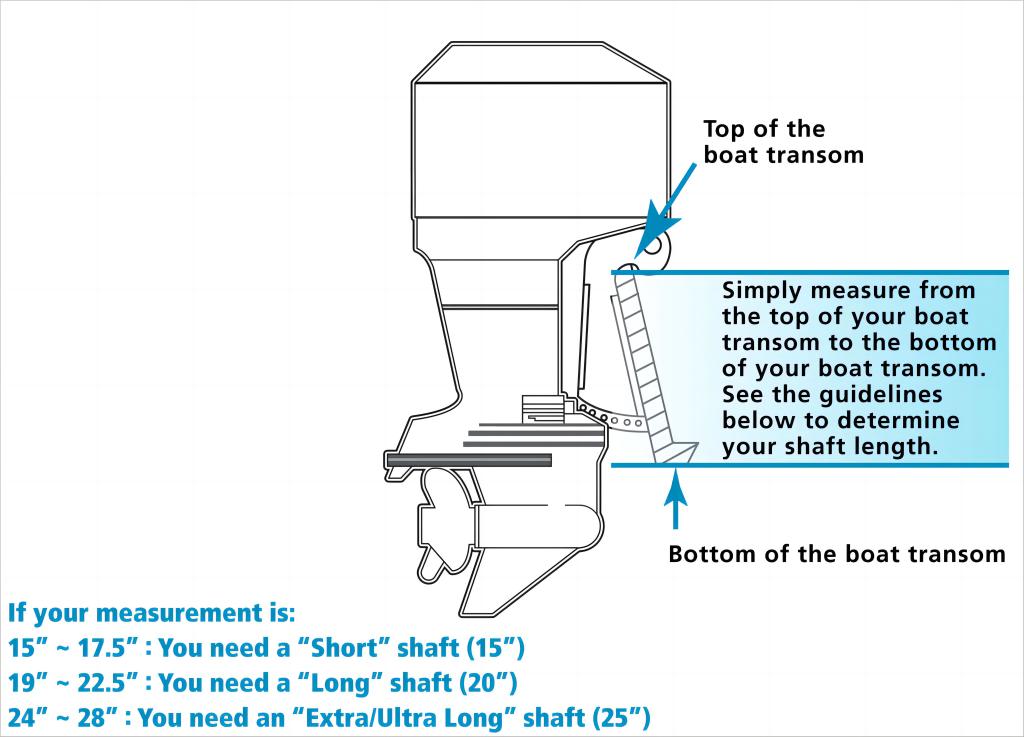Views: 0 Author: Site Editor Publish Time: 2024-07-12 Origin: Site








When it comes to boating, the correct outboard motor shaft length is crucial for optimal performance and safety. The shaft length impacts everything from boat handling to fuel efficiency, and using an outboard motor with an incorrect shaft length can lead to a host of problems. In this blog, we will explore what happens if your outboard shaft is too long, the signs to look for, and how to address this issue.

Outboard motors come with different shaft lengths to accommodate various transom heights. The common shaft lengths are short (15 inches), long (20 inches), and extra-long (25 inches). The shaft length should match the transom height of your boat to ensure the propeller operates at the right depth in the water.

Poor Performance and Efficiency
Increased Drag: An outboard motor with a shaft that is too long will cause the propeller to sit too deep in the water. This increases drag, which can reduce the boat’s speed and fuel efficiency. The boat may feel sluggish and less responsive (Boating Mag).
Cavitation: Cavitation occurs when air bubbles form around the propeller due to improper depth, which can happen if the shaft is too long. This reduces thrust and can cause vibrations, leading to a decrease in performance and potential damage to the propeller (BoatUS).
Handling Issues
Unstable Ride: A deeper propeller can make the boat difficult to handle, especially at higher speeds. The boat may feel less stable and more prone to listing or heeling over, making it harder to control (Marine Engine Digest).
Reduced Maneuverability: Turning and maneuvering the boat can become more challenging. The excessive drag can hinder the boat’s ability to make tight turns, affecting overall navigational control (Boating World).
Increased Wear and Tear
Engine Strain: The motor has to work harder to overcome the additional drag caused by the propeller being too deep in the water. This strain can lead to increased wear on the engine components, reducing the motor’s lifespan (The Hull Truth).
Damage to Propeller and Lower Unit: Operating with an incorrectly sized shaft can expose the propeller and lower unit to potential damage from underwater obstacles and debris, which can be more prevalent at greater depths (Boats.com).
Fuel Consumption
Higher Fuel Usage: Due to the increased drag and strain on the engine, fuel consumption will rise. Boaters will notice they need to refuel more often, making trips more costly and less efficient (Practical Sailor).
Boat Behavior: If your boat is not reaching its expected speed and feels sluggish, it could be due to an overly long shaft.
Water Spray: Excessive water spray around the transom and motor can indicate that the motor is sitting too deep.
Fuel Efficiency: A noticeable increase in fuel consumption without a corresponding increase in usage.
Handling Difficulties: If steering becomes more difficult and the boat seems less stable, it might be a sign.

Measuring Transom Height: To ensure you have the correct shaft length, measure from the top center of the transom to the bottom of the hull (keel). Match this measurement to the appropriate shaft length.
Short Shaft: 15 inches
Long Shaft: 20 inches
Extra-Long Shaft: 25 inches
Adjusting Shaft Length:
Motor Adjustment: Some motors allow for vertical adjustments. Check if the motor bracket has settings to raise or lower the motor.
Jack Plates: Installing a jack plate can help in adjusting the motor height without changing the motor.
Correct Motor: If adjustments are not feasible, consider replacing the motor with one that has the correct shaft length.
Measuring Transom Height:
Ensure accurate measurement from the top center of the transom to the bottom of the hull.
Adjusting Motor Height with a Jack Plate:
Demonstrates the installation and adjustment process using a jack plate.
Effects of Incorrect Shaft Length:
Illustration showing the difference in water drag and boat performance with a long vs. correct shaft length.
Having an outboard shaft that is too long can significantly impact your boating experience. It can lead to poor performance, handling issues, increased wear and tear on your engine, and higher fuel consumption. By understanding the importance of matching your outboard motor shaft length to your boat's transom height and making necessary adjustments, you can ensure a smoother, more efficient, and enjoyable time on the water.
When purchasing a boat or an outboard motor, always check the shaft length to avoid these issues. Proper maintenance and adjustments can enhance the performance and longevity of your boating equipment.
